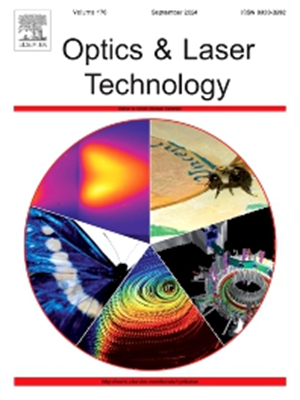通过马赫-曾德干涉仪精确控制波长间隔的可调谐多波长锁模掺铥光纤激光器
IF 5
2区 物理与天体物理
Q1 OPTICS
引用次数: 0
摘要
本研究提出了一种多波长锁模掺铥光纤激光器(TDFL)的实验演示,该激光器采用具有成本效益的全光纤集成马赫-曾德尔干涉仪(MZI)作为光谱滤波器。分析了MZI滤波器的工作机理,论证了其在形成激光光谱和提供精确带宽控制方面的作用。MZI通过诱导其两条臂之间的干涉来工作,其中臂长差(ΔL)决定了自由光谱范围(FSR)。通过调节ΔL,可以精确地控制FSR和脉冲波长间隔。模拟的透射光谱验证了该滤波器的可调性和精度。该激光腔将MZI滤波器、偏振控制器(PC)和黑磷集成在混合锁模方案中。MZI作为梳状过滤器,而PC和黑磷促进模式锁定操作。调整PC改变光纤的折射率,动态调整腔内的过滤波长。该配置可实现1842.1 nm至1897.9 nm的可调单波长输出,覆盖55.8 nm范围。通过改变泵浦功率,激光从单波长转变为四波长锁模。这种创新的设计突出了MZI滤波器在提高掺铥光纤激光器的性能和多功能性方面的潜力,在波长选择性光学传感和诊断方面提供了有前途的应用。本文章由计算机程序翻译,如有差异,请以英文原文为准。
Tunable multi-wavelength mode-locked thulium-doped fiber laser with precise controlled wavelength spacing via Mach-Zehnder interferometer
This study presents an experimental demonstration of a multi-wavelength mode-locked Thulium-doped fiber laser (TDFL) utilizing a cost-effective, fully fiber-integrated Mach-Zehnder interferometer (MZI) as the spectral filter. The working mechanism of the MZI filter is analyzed, demonstrating its role in shaping the laser spectrum and providing precise bandwidth control. The MZI operates by inducing interference between its two arms, where the arm length difference (ΔL) determines the free spectral range (FSR). By adjusting ΔL, the FSR and, consequently, the pulse wavelength spacing can be precisely controlled. Simulated transmission spectra confirm the filter’s tunability and precision. The laser cavity integrates the MZI filter with a polarization controller (PC) and black phosphorus in a hybrid mode-locking scheme. The MZI acts as a comb filter, while the PC and black phosphorus facilitate mode-locked operation. Adjusting the PC alters the refractive index of the fiber, dynamically tuning the filtering wavelength within the cavity. This configuration enables a tunable single-wavelength output spanning 1842.1 nm to 1897.9 nm, covering a 55.8 nm range. By varying the pump power, the laser transitions from single-wavelength to four-wavelength mode-locking. This innovative design highlights the potential of the MZI filter in improving the performance and versatility of Thulium-doped fiber lasers, offering promising applications in wavelength-selective optical sensing and diagnostics.
求助全文
通过发布文献求助,成功后即可免费获取论文全文。
去求助
来源期刊
CiteScore
8.50
自引率
10.00%
发文量
1060
审稿时长
3.4 months
期刊介绍:
Optics & Laser Technology aims to provide a vehicle for the publication of a broad range of high quality research and review papers in those fields of scientific and engineering research appertaining to the development and application of the technology of optics and lasers. Papers describing original work in these areas are submitted to rigorous refereeing prior to acceptance for publication.
The scope of Optics & Laser Technology encompasses, but is not restricted to, the following areas:
•development in all types of lasers
•developments in optoelectronic devices and photonics
•developments in new photonics and optical concepts
•developments in conventional optics, optical instruments and components
•techniques of optical metrology, including interferometry and optical fibre sensors
•LIDAR and other non-contact optical measurement techniques, including optical methods in heat and fluid flow
•applications of lasers to materials processing, optical NDT display (including holography) and optical communication
•research and development in the field of laser safety including studies of hazards resulting from the applications of lasers (laser safety, hazards of laser fume)
•developments in optical computing and optical information processing
•developments in new optical materials
•developments in new optical characterization methods and techniques
•developments in quantum optics
•developments in light assisted micro and nanofabrication methods and techniques
•developments in nanophotonics and biophotonics
•developments in imaging processing and systems

 求助内容:
求助内容: 应助结果提醒方式:
应助结果提醒方式:


